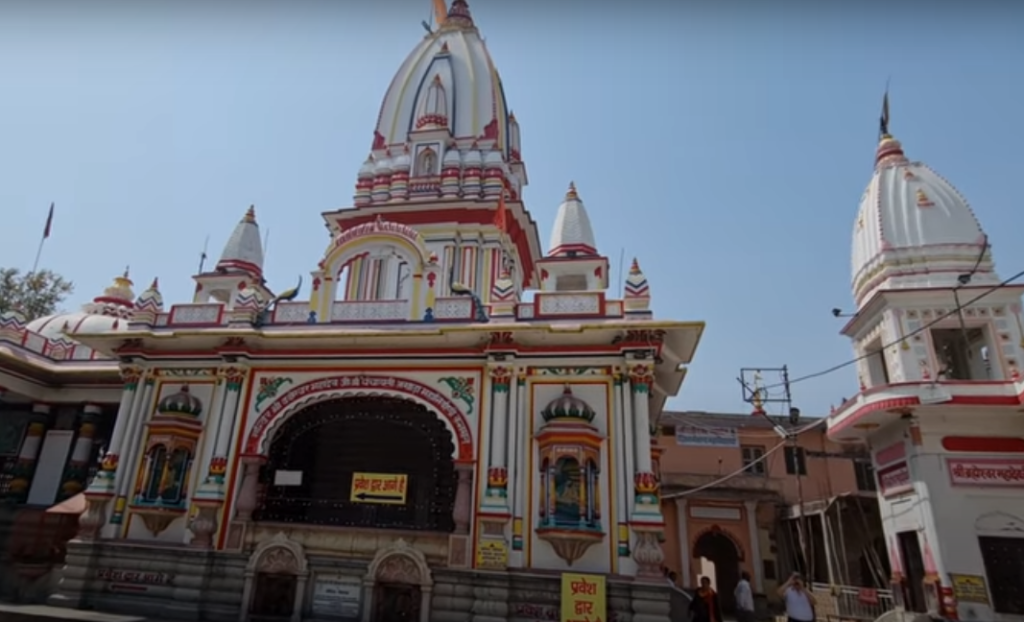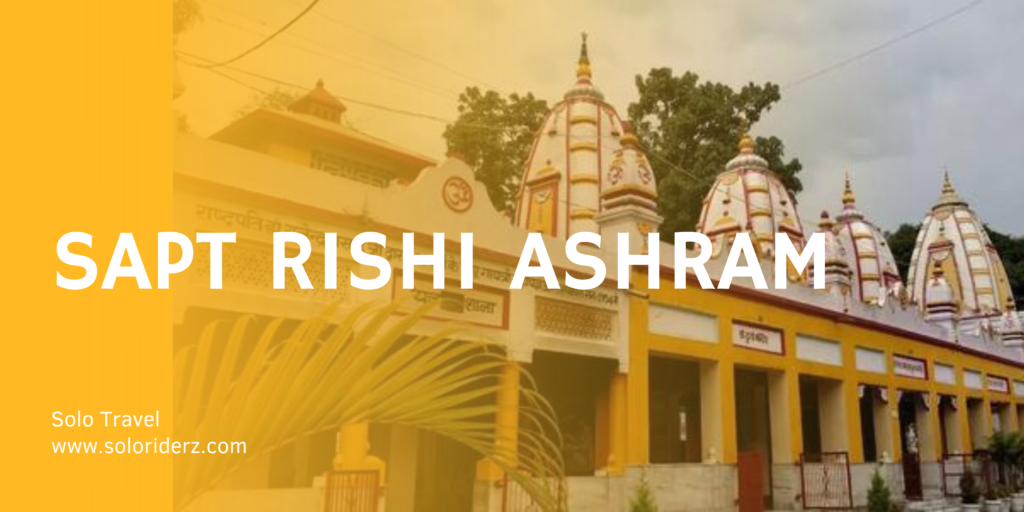
Haridwar Tourist Places
- Exploring the Spiritual Enclave of Haridwar: A Journey through Sacred Sights
- Har Ki Pauri: The Sacred Ghat of the Gods
- Chandi Devi Mandir- The Devine Feminine Power
- Mansa Devi Temple – A spiritual journey
- Shanti Kunj in Haridwar
- Daksheshwar Mahadev Temple
- Pawan Dham – Haridwar Tourist Places
- Maya Devi Temple – Tracing the Divine Feminine in Haridwar
- Sapt Rishi Ashram – A Spiritual Retreat
- Rajaji National Park: Where Wilderness Meets Tranquility
- Patanjali Yogpeeth: Nurturing Holistic Wellness in the Lap of Nature
- Ayurveda and Natural Healing
- Useful Links
- Frequently Asked Questions (FAQ) about Haridwar Tourist Places
Exploring the Spiritual Enclave of Haridwar: A Journey through Sacred Sights
Haridwar Tourist Places is a major pilgrimage center of India. Devotees of all walks come to Haridwar to take the holy dip in the Ganges. The city nestled along the banks of the holy river Ganges in Uttarakhand, India, is a captivating destination for spiritual seekers and travelers. Offering a plethora of enchanting tourist places, Haridwar is a melting pot of spirituality, culture, and natural beauty. Let’s embark on a journey to discover these sacred sights and explore how to reach them.
The Haridwar railway station looks like a temple from the outside. The Haridwar bus stand is approx 3 km. You can board an auto rikshaw to reach har ki Pauri.
Har Ki Pauri: The Sacred Ghat of the Gods

Nestled on the banks of the holiest river in Hinduism, the Ganges, Har Ki Pauri in Haridwar is a revered ghat that stands as a timeless witness to centuries of spiritual fervor and cultural heritage. Translated as “Steps of Lord Shiva,” Har Ki Pauri is not just a physical location but a spiritual beacon drawing pilgrims, seekers, and visitors into its embrace.
The main attraction of Haridwar is “Har ki Pauri”. Which is 3 kilometers distance from the bus stand and railway station. You can board an electric or cycle rickshaw.
Har Ki Pauri, one of the most iconic tourist places in Haridwar, can be easily reached as it lies in the heart of the city. If you’re arriving by train, the Haridwar Railway Station is merely 1.5 kilometers away. From there, you can hire a cycle-rickshaw, auto-rickshaw, or taxi to reach Har Ki Pauri.
For those traveling by air, the nearest airport is the Jolly Grant Airport in Dehradun, approximately 35 kilometers from Haridwar. From the airport, you can avail of pre-paid taxis or buses to reach the sacred ghat.
Spiritual Significance
Ganga Aarti
The hallmark of Har Ki Pauri is the enchanting Ganga Aarti that takes place every evening. As the sun sets, priests clad in saffron robes perform a synchronized ritual, choreographing the rhythmic movements of lamps and chanting hymns. The riverbank comes alive with the divine melody, creating an ethereal atmosphere that transcends the mundane.
Divine Dips
Har Ki Pauri is believed to be the spot where Lord Shiva left his footprint, making it a sacred site for Hindu devotees. Pilgrims come from far and wide to take a holy dip in the Ganges, believing that the waters carry the blessings of Lord Shiva and cleanse them of sins.
Architectural Marvels
Brahmakund
At the heart of Har Ki Pauri lies Brahmakund, a sacred ghat with a large footprint-shaped stone that marks the spot where Lord Brahma is believed to have performed a yajna. Pilgrims gather here to offer prayers and immerse themselves in the spiritual vibrations of this ancient site.
Ghat Construction
Har Ki Pauri has undergone renovations over the centuries, but its architectural charm remains intact. The ghat features steps leading down to the Ganges, intricately carved balusters, and the embellished entrance known as Harki Pauri Gate, creating a visual spectacle that mirrors the cultural richness of the region.
Rituals and Festivals
Kumbh Mela
Har Ki Pauri is a focal point during the Kumbh Mela, a grand religious gathering that takes place every twelve years. Millions of pilgrims converge here to participate in rituals, seek blessings, and take part in the ceremonial bathing, considering it a rare opportunity for spiritual purification.
Kanwar Yatra
During the Kanwar Yatra, devotees carry sacred water from the Ganges in pitchers on their shoulders, walking miles to offer it at temples dedicated to Lord Shiva. Har Ki Pauri becomes a significant stop during this yatra, symbolizing the devotion and penance of the participants.
Practical Information
Har Ki Pauri Ghat
The ghat is accessible throughout the year, and the early morning and evening hours provide a tranquil atmosphere for prayer and reflection.
Best Time to Visit
The winter months (October to February) offer pleasant weather, while the festival season and Ganga Aarti make the months of October and November particularly vibrant.
Nearby Attractions
Har Ki Pauri is in close proximity to other attractions in Haridwar, such as Mansa Devi Temple and Chandi Devi Temple, allowing visitors to explore the spiritual tapestry of the city.
Conclusion
Har Ki Pauri, with its spiritual resonance, architectural splendor, and cultural significance, stands as a timeless symbol of devotion and unity. As you stand on the sacred steps, witnessing the flow of the Ganges and the flickering lamps in the evening breeze, you become part of a spiritual legacy that transcends time—a legacy etched into the very soul of Har Ki Pauri.
Chandi Devi Mandir– The Devine Feminine Power
Another prominent temple in Haridwar is the Chandi Devi Temple, situated atop the Neel Parvat hill. Like the Mansa Devi Temple, reaching Chandi Devi involves a trek or a cable car ride. The temple is dedicated to Goddess Chandi, a fierce form of Goddess Durga. Apart from its religious significance, the temple location provides an opportunity to relish breathtaking panoramic views of Haridwar.
Maa Chandi Devi Temple is situated on the Neel Parvat of Shivalik Hills. This is the Siddhi peeth. The devotees from all over India come to take the blessings of Maa Chandi Devi though-out the year. During Navratri, the temple is flooded with devotees the whole day.
To reach Maa Chandi Devi temple, either you trek for 45 minutes to 1 hour uphill or you can take the ropeway. A Ropeway ticket will cost you Approx INR 200 to INR 300. (please check the price it may have changed)
Mythical Origins
Legend of Chanda-Munda
Chandi Devi Temple derives its name from the goddess Chandi, who is believed to have manifested to annihilate the demon kings Chanda and Munda. According to Hindu mythology, the goddess emerged from the collective energies of various deities, symbolizing the unified cosmic power that triumphs over evil forces.
The Anjana Connection
Legend has it that Chandi Devi is also associated with Anjana, the mother of Lord Hanuman. Devotees believe that worshipping Chandi Devi brings blessings and protection, and the temple holds a special place in the hearts of those seeking strength and courage.
Spiritual Ascension
Pilgrimage to Chandi Devi
Devotees often undertake a pilgrimage to Chandi Devi Temple, and one of the traditional ways to reach the temple is by trekking through the Neel Parvat. The journey offers not only physical exertion but also a symbolic ascent towards spiritual elevation, reflecting the ardent devotion of the pilgrims.
Aerial Ropeway
For those seeking a less strenuous journey, an aerial ropeway provides a scenic and convenient way to reach the temple. The cable car ride offers breathtaking views of the surrounding landscapes, creating an immersive experience before arriving at the divine abode.
Architectural Marvel
Temple Structure
Chandi Devi Temple showcases North Indian architectural influences, with its distinctive spire and intricate carvings. The temple’s sanctum sanctorum houses the idol of Chandi Devi, adorned with traditional ornaments, creating a divine ambiance that resonates with the spiritual energy of the goddess.
Surrounding Scenery
Beyond the temple structure, the panoramic views from the Neel Parvat add to the enchanting experience. The Ganges flowing below, the town of Haridwar, and the distant Himalayan peaks create a serene backdrop that complements the spiritual aura of the temple.
Festivals and Celebrations
Navratri
Chandi Devi Temple comes alive during the festival of Navratri, a nine-night celebration dedicated to the divine feminine. Devotees gather to participate in special prayers, rituals, and cultural events, fostering an atmosphere of joyous devotion.
Ashwin Navami
Ashwin Navami, the birthday of Chandi Devi, is another significant celebration at the temple. Pilgrims throng to seek the goddess’s blessings on this auspicious occasion, adding vibrant colors to the spiritual tapestry of the region.
Practical Information
Temple Timings
Chandi Devi Temple is open to devotees throughout the week, with specific timings for darshan (worship) and aartis. The morning hours are often preferred for a serene and less crowded experience.
The Temple remains open from morning 7:00 AM to Evening 07:00 PM.
Weather Considerations
The best time to visit is during the months of September to June when the weather is pleasant, making the pilgrimage and the trek more comfortable.
Pilgrim Facilities
The temple provides basic facilities for pilgrims, including resting areas, refreshments, and spaces for prayer and contemplation.
Conclusion
Chandi Devi Temple, perched on the Neel Parvat, beckons all who seek the blessings and protection of the divine feminine. As you stand in the presence of the goddess, surrounded by the panoramic vistas of the Himalayas and the flowing Ganges, you embark on a spiritual sojourn that transcends the physical realm. Chandi Devi Temple is not merely a structure; it is a sanctuary of strength, courage, and divine grace—an eternal beacon on the spiritual path.
Mansa Devi Temple – A spiritual journey

Mansa Devi Temple is situated at a distance of approximately 2.5 kilometers from Har Ki Pauri in Haridwar. The proximity between these two significant pilgrimage sites makes it convenient for devotees to include both in their spiritual journey. Whether you choose to walk, take a rickshaw, or opt for the scenic cable car ride, the journey from Har Ki Pauri to Mansa Devi Temple is a seamless part of the spiritual sojourn in this sacred city.
The Origin Story
Mansa Devi Temple has a history as intriguing as its spiritual significance. Legends whisper that the temple was constructed in the 17th century by Maharaja Gopal Singh of Mani Majra. The magnetic allure of the temple is attributed to the divine presence of Goddess Mansa Devi, the wish-fulfilling deity believed to grant the deepest desires of her devotees.
Architectural Marvels
As you step into the temple complex, the architectural prowess of the region becomes evident. Intricate carvings, vibrant frescoes, and the overall design of the temple are a testament to the skilled craftsmanship of the bygone era. The blend of North Indian and Nagara architectural styles adds a unique charm to Mansa Devi Temple.
Spiritual Significance
Goddess Mansa Devi
Mansa Devi, the benevolent goddess worshipped here, is a symbol of wish fulfillment and protection. Pilgrims flock to seek her blessings, tying threads on the sacred tree within the temple premises, believed to make their wishes come true. The aura of divinity surrounding the deity permeates every corner, creating an atmosphere of serenity and reverence.
Rituals and Festivals
The temple comes alive during festivals, with Navratri being the most celebrated. The air resonates with devotional hymns, and the vibrant colors of the festivities mirror the enthusiasm of the worshippers. The divine energy during these occasions is palpable, making Mansa Devi Temple a must-visit during the festive season.
Exploring the Temple Complex
The Main Shrine
At the heart of the complex stands the main shrine dedicated to Goddess Mansa Devi. The idol, adorned with resplendent ornaments, exudes an aura of divine grace. The rhythmic chants of the priests and the fragrance of incense create an immersive experience for the devotees.
Siddh Peeth
Adjacent to the main shrine is the Siddh Peeth, a revered spot believed to fulfill the spiritual aspirations of those who meditate here. The tranquil ambiance and panoramic views of the surrounding hills make it an ideal place for introspection and connecting with the divine.
Practical Information for Pilgrims
How to Reach
Mansa Devi Temple is easily accessible from Haridwar, a significant pilgrimage destination in itself. Devotees can reach the temple by cable car, a journey that not only facilitates a convenient commute but also offers breathtaking views of the Ganges and the sprawling city below.
Best Time to Visit
While the temple welcomes devotees throughout the year, the months of March to June provide pleasant weather for a comfortable pilgrimage experience. Avoiding the monsoon season is advisable due to the hilly terrain leading to the temple.
conclude
In the embrace of the majestic Himalayas, Mansa Devi Temple stands as a beacon of spirituality and cultural heritage. The journey to this sacred abode is not just a physical one but a soul-stirring experience, weaving together history, architecture, and divine blessings. As you stand in the shadow of the temple, overlooking the expanse below, you can’t help but feel the transcendental connection to something beyond the tangible – a connection that makes Mansa Devi Temple an unrivaled destination for seekers of both spiritual solace and architectural marvels.
Shanti Kunj in Haridwar
Nestled in the heart of Haridwar, Shanti Kunj stands as a tranquil oasis, offering a serene escape from the hustle and bustle of everyday life. This spiritual haven, situated approximately 6 kilometers from Har Ki Pauri, beckons seekers of peace and introspection.
A Spiritual Retreat
Shanti Kunj, which translates to “Grove of Peace,” lives up to its name with lush greenery, flowering plants, and a soothing ambiance that envelopes visitors upon arrival. Founded by revered spiritual leader Pandit Shriram Sharma Acharya ji, the ashram is dedicated to fostering spiritual growth, holistic healing, and environmental consciousness. Shanti Kunj is founded by Shri Shriram Sharma Acharya ji.
Shanti Kunj is located on Haridwar- Rishikesh road. It is the main center for Gayatri Parivar. Vedic chants in the ashrams a the daily routine. You hear the Vedic chants early in the morning around 3:30 AM and the Gayatri mantra chants all around the ashram.
Holistic Practices
Yoga and Meditation
Shanti Kunj is renowned for its emphasis on holistic well-being. The ashram offers regular sessions of yoga and meditation, providing visitors with the opportunity to rejuvenate their mind, body, and soul. The serene surroundings enhance the practice, creating an ideal environment for inner reflection.
Ayurvedic Healing
The ashram also embraces Ayurveda, the ancient Indian system of medicine. Visitors can partake in Ayurvedic therapies and treatments, promoting physical and mental wellness. The combination of natural surroundings and traditional healing practices makes Shanti Kunj a unique destination for those seeking a holistic approach to health.
Eco-Friendly Initiatives
Shanti Kunj is not just a spiritual retreat; it’s a beacon of environmental consciousness. The ashram actively promotes eco-friendly practices, from waste management to sustainable living. The lush gardens and clean surroundings exemplify the commitment to preserving the natural beauty that surrounds Shanti Kunj.
Connecting with Nature
Medicinal Plant Garden
A highlight of Shanti Kunj is its medicinal plant garden, where visitors can explore and learn about various herbs and plants with therapeutic properties. This educational experience adds a dimension of awareness to the spiritual journey, connecting individuals with the healing power of nature.
Reflective Pools and Walking Trails
The ashram features reflective pools and well-maintained walking trails, inviting visitors to engage in contemplative strolls amidst the natural beauty. These areas provide a perfect setting for moments of solitude and self-discovery.
Practical Information for Visitors
Timings and Entry
Shanti Kunj is open to visitors throughout the week. The tranquil atmosphere is best experienced during the early morning and evening hours. The ashram welcomes individuals from all walks of life, fostering an inclusive environment for spiritual seekers.
Entry to the ashram is free. But you have to get the registration done at the entrance of the ashram. Before visiting Shanti Kunj please carry your identity proof (Aadhar card) when you do registration at the reception.
Once you enter the ashram, a fragrance of yagna surrounds the place. The soft sound of the Gayatri mantra chanting and a peaceful calm atmosphere relieve you from all worldly stress.
Accommodation
For those wishing to delve deeper into the spiritual experience, Shanti Kunj offers accommodation facilities. The simple yet comfortable lodging allows visitors to immerse themselves fully in the ashram’s serene and spiritual ambiance.
Conclusion
Shanti Kunj, with its emphasis on tranquility, holistic well-being, and eco-conscious living, is more than an ashram—it’s a destination for rejuvenation and self-discovery. As you step into this haven of peace, the cares of the world melt away, and the rhythmic flow of life takes on a more serene cadence. For seekers of inner harmony and environmental mindfulness, Shanti Kunj is a must-visit, a verdant sanctuary in the heart of Haridwar.
Daksheshwar Mahadev Temple

Daksheshwar Mahadev Temple: Where Divinity Meets Serenity
In the spiritual tapestry of Haridwar, the Daksheshwar Mahadev Temple emerges as a sacred gem, weaving together history, mythology, and a tranquil ambiance. Situated on the Kankhal Road, this temple holds a special place in the hearts of devotees and visitors seeking a profound connection with the divine.
Daksha Mahadev Temple is another tourist place in Haridwar. It’s one of the oldest temples in Haridwar. The temple is located in the Kankhal in Haridwar. The name of this temple is kept in the name of Daksh Maharaj, the father of Mata Sati.
In this Temple, you will see Daksh Ghat and Yajna Kund. The temple is open throughout the day. But during Sawan month the temple is crowded.
Mythical Origins
Legend of King Daksha
The temple derives its name from the legendary King Daksha, a key figure in Hindu mythology. It is believed that King Daksha was the father of Goddess Sati, the first wife of Lord Shiva. The temple stands on the site where Daksha performed a grand yajna (ritual sacrifice) but intentionally excluded Lord Shiva. The ensuing events, including the self-immolation of Goddess Sati, led to the manifestation of Lord Shiva in the form of Daksheshwar Mahadev.
Aesthetic Grandeur
Daksheshwar Mahadev Temple is an architectural marvel, showcasing intricate carvings, artistic embellishments, and a design that reflects the cultural heritage of the region. The temple’s spires reach skyward, capturing the attention of all who approach. The blend of traditional North Indian and contemporary architectural styles adds to its visual appeal.
Holy Ponds
Surrounding the temple are sacred ponds, believed to have divine significance. Pilgrims often take ritualistic dips in these ponds, considering it an auspicious act that purifies the soul. The serene waters add to the overall peaceful ambiance of the temple complex.
Spiritual Significance
The Lingam of Lord Shiva
Central to the sanctum sanctorum of Daksheshwar Mahadev Temple is the sacred lingam, representing Lord Shiva. Devotees come from far and wide to offer prayers and seek the blessings of Lord Shiva, believing that the deity here holds the power to absolve sins and grant spiritual elevation.
Religious Celebrations
The temple comes alive during festivals, especially during the Maha Shivaratri, when a vibrant celebration takes place. Devotees participate in religious rituals, sing devotional hymns, and immerse themselves in the divine energy that permeates the air.
Pilgrim’s Practical Guide
Visiting Hours
Daksheshwar Mahadev Temple is open to devotees every day. The optimal times for a visit are during the early morning and evening, allowing for a serene and less crowded experience.
The temple is open from morning 06:00 AM to evening 08:00 PM,
Festive Seasons
For a more immersive experience, plan your visit during major festivals, especially Maha Shivaratri, when the temple resonates with spiritual fervor and joyous celebrations.
Respectful Attire
Given the sacred nature of the temple, visitors are advised to dress modestly and maintain a respectful demeanor during their time on the premises.
Conclusion
Daksheshwar Mahadev Temple stands not just as a physical structure but as a spiritual beacon, connecting the mortal realm with the divine. Its mythical origins, architectural splendor, and spiritual ambiance make it a place where history, mythology, and faith intertwine. As you stand in the presence of the sacred lingam, surrounded by the echoes of ancient legends, Daksheshwar Mahadev Temple invites you on a journey of reverence and spiritual discovery, embodying the essence of Haridwar’s rich cultural and religious heritage.
Pawan Dham – Haridwar Tourist Places
Pawan Dham: A Serene Haven of Devotion and Artistry
Nestled along the banks of the sacred Ganges in Haridwar, Pawan Dham stands as a testament to both spiritual devotion and artistic brilliance. This revered temple, dedicated to Lord Ram, draws pilgrims and art enthusiasts alike, offering a unique blend of religious sanctity and aesthetic allure.
Pawan Dham is approx. 2 km from Haridwar. The beauty of Pawan Dham is its interior and all the idols are made from pieces of glass. The Pawan Dham is managed by a non-profit organization Geeta Bhawan Trust Society.
Architectural Grandeur
Glass and Mirror Work
Pawan Dham is renowned for its exquisite glass and mirror work that adorns the entire temple structure. The intricate craftsmanship creates a mesmerizing play of light and color, transforming the temple into a radiant spectacle. Every inch of the temple seems to shimmer with spiritual energy, captivating the hearts of those who visit.
Ornate Carvings
Beyond its glass facade, Pawan Dham boasts ornate carvings that depict scenes from Hindu mythology. The skilled artisans have meticulously crafted these details, turning the temple into a living canvas that narrates tales of divinity and valor. Each carving is a testament to the cultural richness embedded in the temple’s architecture.
Spiritual Significance
Devotion to Lord Ram
Pawan Dham is dedicated to Lord Ram, a revered figure in Hinduism. Devotees flock to the temple to seek blessings and find solace in the serene atmosphere that envelops the sacred premises. The spiritual vibrations resonate as worshippers engage in prayers and rituals, creating an ambiance of deep reverence.
Peaceful Surroundings
Situated away from the bustling city, Pawan Dham offers a tranquil retreat for those seeking a moment of introspection and connection with the divine. The serene surroundings, coupled with the artistic beauty of the temple, make it a place where spirituality and aesthetics converge.
Artistic Splendor
Glass Mosaics and Mirror Inlays
The highlight of Pawan Dham is undoubtedly its intricate glass mosaics and mirror inlays. The play of light on these reflective surfaces creates a dynamic visual experience, making the temple a must-visit for admirers of art and architecture. The craftsmanship reflects a harmonious blend of tradition and innovation.
Sculptures and Idols
In addition to the glasswork, Pawan Dham features sculptures and idols that capture the essence of Hindu mythology. Each sculpture is a work of art, portraying deities and mythological characters with a level of detail that showcases the skill and dedication of the craftsmen.
Visitor Information
Timings
Pawan Dham is open to visitors every day from morning until evening. The morning hours offer a serene atmosphere, while the evening illuminations highlight the artistic brilliance of the glasswork.
Entry is free and it is open from morning 06:00 AM to 08:00 PM. It is one of the ancient temples of Haridwar.
Photography
Visitors are often captivated by the visual splendor of Pawan Dham, and photography is allowed. Capturing the play of light on the glass and mirror work is particularly enchanting.
Respectful Conduct
Given the temple’s religious significance, visitors are encouraged to maintain a respectful demeanor and adhere to any guidelines provided by the temple authorities.
Conclusion
Pawan Dham, with its breathtaking artistry and spiritual ambiance, transcends the conventional boundaries of a temple. It stands not only as a place of worship but as a living canvas that narrates stories of faith and artistic excellence. As you step into the radiant embrace of Pawan Dham, you embark on a journey where devotion and art coalesce, inviting you to experience the divine in a uniquely visual and spiritual way.
Maya Devi Temple – Tracing the Divine Feminine in Haridwar

Nestled in the sacred city of Haridwar, Maya Devi Temple is a revered sanctuary that echoes with the whispers of centuries-old devotion. Dedicated to Goddess Maya, a manifestation of the divine feminine, this temple stands as a testament to the rich cultural and spiritual heritage of the region.
As one of the Shakti Peethas (divine shrines dedicated to Goddess Shakti), the Maya Devi Temple is an ancient and historically rich site in Haridwar.
The temple is believed to be the spot where the heart and navel of Goddess Sati (an incarnation of Shakti) fell during her self-immolation. Pilgrims visit this revered temple to seek blessings and immerse themselves in the city’s deep-rooted spiritual heritage.
Historical Tapestry
Ancient Roots
Maya Devi Temple boasts a history that stretches back through the annals of time. Believed to be one of the Siddha Peethas, a sacred spot where body parts of Goddess Sati fell during Lord Shiva’s cosmic dance, the temple holds immense mythological significance. The sanctity of this place is palpable, drawing pilgrims and history enthusiasts alike.
Renovation and Preservation
While the original temple is ancient, it underwent renovations in the 19th century under the patronage of the Queen of Indore, Ahilyabai Holkar. The restoration efforts have preserved the temple’s architectural splendor, allowing present-day visitors to witness the seamless blend of history and reverence.
Architectural Marvels
Shikhara and Carvings
Maya Devi Temple showcases Nagara-style architecture with its distinctive shikhara (spire). The temple’s exterior is adorned with intricate carvings, depicting mythological scenes and symbols. The craftsmanship is a visual feast, reflecting the artistic brilliance of the artisans who contributed to its construction and renovation.
Sacred Pindi
Central to the temple is the sacred pindi, a stone representation of Goddess Maya. Devotees offer prayers and perform rituals in front of this divine symbol, seeking the blessings of the goddess believed to be an embodiment of Shakti, the cosmic feminine energy.
Spiritual Significance
Goddess Maya
Goddess Maya is revered as a compassionate deity, often approached by devotees seeking protection and blessings for their families. The temple holds a special place in the hearts of those who acknowledge the divine feminine as a source of strength and nurturing energy.
Vibrant Festivals
Maya Devi Temple comes alive during festivals, with Navratri being a particularly vibrant celebration. The temple complex buzzes with activity as devotees gather to participate in religious rituals, cultural events, and processions that honor Goddess Maya.
Pilgrim’s Practical Guide
Accessibility
Maya Devi Temple is centrally located in Haridwar, making it easily accessible for pilgrims and visitors. The temple is situated near the bustling market, allowing for a seamless blend of spiritual and cultural experiences.
Timings
The temple welcomes devotees throughout the day, and the early morning and evening hours offer a tranquil atmosphere for those seeking moments of reflection and prayer.
Rituals and Offerings
Participating in the temple rituals and offering simple puja items can enhance the spiritual experience. The priests within the temple provide guidance for those unfamiliar with the customs.
Conclusion
Maya Devi Temple, with its ancient roots, architectural splendor, and spiritual ambiance, beckons all who seek a connection with the divine feminine. As you step into the hallowed grounds of this sacred sanctuary, you are not just entering a temple; you are immersing yourself in a timeless tapestry of devotion, history, and reverence for the eternal feminine energy that permeates the cosmos. Maya Devi Temple stands as a living testament to the enduring spiritual legacy of Haridwar.
Sapt Rishi Ashram – A Spiritual Retreat

In the serene embrace of Haridwar, nestled along the banks of the holy Ganges, Sapt Rishi Ashram emerges as a spiritual haven—a sanctuary for seekers, sages, and those yearning for a profound connection with the divine. This ashram, steeped in the wisdom of ancient sages, invites visitors on a transformative journey of self-discovery and spiritual awakening.
Located near Har Ki Pauri, the Sapt Rishi Ashram is a peaceful oasis where seven great sages, or ‘Sapt Rishis,’ are believed to have meditated.
The ashram’s tranquil environment provides an excellent opportunity for spiritual seekers to engage in meditation, yoga, and self-reflection amidst the serene surroundings and the gentle flow of the Ganges.
Tranquil Setting
Riverside Serenity
Sapt Rishi Ashram is strategically located in a tranquil setting, far from the hustle and bustle of urban life. Surrounded by lush greenery and the gentle murmur of the Ganges, the ashram offers a serene environment conducive to meditation, introspection, and spiritual practices.
Proximity to Nature
The ashram’s proximity to nature enhances the spiritual experience, providing seekers with the opportunity to attune themselves to the natural rhythms and energies that flow along the sacred river. The rustling leaves and the flowing waters create a symphony that harmonizes with the ashram’s spiritual ambiance.
Historical Significance
Abode of Seven Sages
The name “Sapt Rishi” translates to “Seven Sages,” paying homage to the legendary seven sages who are said to have meditated at this very spot. The ashram stands as a living testament to their profound spiritual practices and the divine vibrations they infused into the surroundings.
Mythological Connections
According to Hindu mythology, it is believed that Lord Vishnu appeared here in his incarnation as Lord Krishna to bless the seven sages. The ashram’s history is interwoven with such mythological narratives, adding a layer of sacredness to the spiritual retreat.
Spiritual Practices
Meditation and Yoga
Sapt Rishi Ashram is a haven for meditation and yoga enthusiasts. The peaceful ambiance, coupled with the guidance of experienced teachers, allows visitors to delve deep into these ancient practices. The ashram hosts regular meditation and yoga sessions, creating an atmosphere of mindfulness and self-reflection.
Spiritual Discourses
The ashram often hosts spiritual discourses and lectures by seasoned scholars and enlightened beings. These sessions provide seekers with insights into the profound teachings of spirituality, philosophy, and the path to self-realization.
Practical Information
Accommodation
For those seeking a prolonged spiritual retreat, Sapt Rishi Ashram offers simple and comfortable accommodation facilities. The austere yet welcoming lodgings allow visitors to immerse themselves fully in the ashram’s spiritual ambiance.
Visitor Guidelines
As a place of spiritual reverence, visitors are encouraged to adhere to the ashram’s guidelines, which often include maintaining silence during specific hours, respecting the natural surroundings, and participating in ashram activities with an open heart.
Conclusion
Sapt Rishi Ashram stands as more than just a physical retreat; it is a doorway to the timeless wisdom of the sages, a bridge between the modern world and the ancient spiritual traditions. As you step into the hallowed grounds of Sapt Rishi Ashram, you embark on a journey of self-discovery, guided by the echoes of millennia-old wisdom and the gentle flow of the sacred Ganges—a journey that transcends time and connects the seeker to the eternal essence of existence.
Rajaji National Park: Where Wilderness Meets Tranquility
Nestled in the foothills of the Shivalik Range in Uttarakhand, Rajaji National Park stands as a pristine expanse of wilderness, offering a haven for nature enthusiasts and wildlife lovers. This expansive national park, spanning across the districts of Haridwar, Dehradun, and Pauri Garhwal, is not only a biodiversity hotspot but also a retreat into the heart of untamed beauty.
For nature enthusiasts, a visit to Rajaji National Park is a must. Situated on the outskirts of Haridwar, this vast wildlife sanctuary is home to a diverse range of flora and fauna. From majestic elephants and elusive tigers to various bird species, the park offers thrilling jeep safaris and elephant rides, allowing visitors to experience the wild wonders of nature up close.
Breathtaking Biodiversity
Fauna Diversity
Rajaji National Park is a treasure trove of biodiversity, housing a diverse array of wildlife. The park is home to the majestic Bengal tiger, Asian elephant, leopards, and several species of deer, making it a haven for wildlife enthusiasts and conservationists alike. The birdwatching opportunities are equally captivating, with over 315 avian species gracing the skies.
Iconic Elephants
The park is renowned for its elephant population, and witnessing these gentle giants in their natural habitat is a surreal experience. The Ramganga River, flowing through the park, provides a lifeline for the diverse flora and fauna, creating an ecosystem that sustains these magnificent creatures.
Scenic Landscapes
Shivalik Range
Rajaji National Park’s landscape is a mesmerizing tapestry of dense forests, grasslands, and the rugged terrain of the Shivalik Range. The park’s undulating topography offers panoramic views of the Himalayan foothills, creating a picturesque backdrop for wildlife safaris and nature walks.
Rivers and Streams
Numerous rivers and streams crisscross the park, with the Ganges, Yamuna, and Song rivers being prominent. These water bodies not only enhance the scenic beauty but also serve as vital water sources for the park’s inhabitants.
Safari Adventures
Wildlife Safaris
Embarking on a wildlife safari within Rajaji National Park is a thrilling experience. The park offers both jeep safaris and elephant safaris, allowing visitors to traverse through different zones and catch glimpses of the diverse wildlife, from the elusive big cats to the vibrant birdlife.
Nature Walks
For those seeking a more intimate connection with nature, guided nature walks are available. Experienced naturalists accompany visitors, providing insights into the park’s flora, fauna, and ecological significance.
Conservation Efforts
Project Elephant
Rajaji National Park actively participates in conservation initiatives, including Project Elephant, to protect and preserve the endangered Asian elephant population. The park’s commitment to wildlife conservation and sustainable practices contributes to the region’s ecological health.
Eco-Tourism Initiatives
The park encourages eco-tourism, aiming to strike a balance between promoting responsible tourism and safeguarding the natural habitat. Visitors can engage in eco-friendly activities, fostering a sense of environmental consciousness.
Practical Information
Entry Points
Rajaji National Park has multiple entry points, including Haridwar, Chilla, and Rishikesh. Visitors can choose their entry point based on convenience and accessibility.
Best Time to Visit
Please check with the National Park authority. May be from November to June. The winter months, from December to March, offer pleasant weather, making it an ideal time for wildlife safaris.
Visitor Guidelines
To ensure the well-being of both visitors and wildlife, adhering to park guidelines is crucial. These guidelines include maintaining a safe distance from animals, refraining from littering, and following the instructions of park authorities.
Conclusion
Rajaji National Park, with its captivating landscapes and diverse wildlife, beckons all who seek to reconnect with nature’s untamed beauty. As you traverse the trails and witness the rich biodiversity, the park becomes not just a destination but a testament to the importance of preserving wilderness for future generations. Rajaji National Park stands as a testament to the harmonious coexistence of wildlife and nature enthusiasts, inviting all to partake in the conservation journey and savor the beauty of the wild.
Patanjali Yogpeeth: Nurturing Holistic Wellness in the Lap of Nature
Nestled on the banks of the serene Ganges in Haridwar, Patanjali Yogpeeth stands as a holistic wellness center and a beacon of ancient yogic wisdom. Founded by renowned yoga guru Swami Ramdev, this sprawling ashram not only imparts the teachings of traditional yoga but also serves as a hub for Ayurveda, spiritual rejuvenation, and the pursuit of overall well-being.
Yoga and Meditation
Yogic Practices
Patanjali Yogpeeth is dedicated to the teachings of Sage Patanjali, emphasizing the holistic approach of yoga encompassing physical postures (asanas), breath control (pranayama), and meditation. The ashram conducts regular yoga sessions, catering to practitioners of all levels, from beginners to advanced.
Meditation Retreats
The serene ambiance of the ashram, coupled with the meditative surroundings, makes Patanjali Yogpeeth an ideal destination for meditation retreats. Visitors can immerse themselves in guided meditation sessions, fostering inner peace and spiritual growth.
Ayurveda and Natural Healing
Ayurvedic Treatments
Patanjali Yogpeeth is renowned for its Ayurvedic treatments and therapies. The ashram follows the principles of Ayurveda, offering holistic healing through natural remedies, herbal medicines, and therapeutic practices. Visitors can avail themselves of personalized Ayurvedic consultations and treatments.
Herbal Gardens
The ashram boasts expansive herbal gardens, cultivating a variety of medicinal plants used in Ayurveda. Visitors can explore these gardens, gaining insights into the healing properties of indigenous herbs and plants.
Spiritual Discourses
Wisdom Talks
Patanjali Yogpeeth hosts spiritual discourses by Swami Ramdev and other enlightened speakers. These talks cover a range of topics, including philosophy, spirituality, and the integration of ancient wisdom into modern life.
Satsangs
Regular satsangs (spiritual gatherings) are organized, where devotees come together to chant mantras, sing devotional songs, and share in the collective energy of spiritual communion.
Residential Facilities
Accommodation
Patanjali Yogpeeth offers residential facilities for those seeking a more immersive experience. The accommodations are designed to provide a simple and serene environment conducive to spiritual practice and well-being.
Vegetarian Cuisine
The ashram promotes a vegetarian lifestyle, and the on-site dining facilities offer nutritious and Ayurvedically-balanced meals. The emphasis on sattvic (pure and harmonious) food aligns with the yogic principles followed at the ashram.
Community Outreach
Yoga Camps
Patanjali Yogpeeth conducts yoga camps and workshops, both within the ashram and in various locations globally. These initiatives aim to spread awareness about the benefits of yoga and holistic living.
Charitable Activities
Swami Ramdev’s vision extends to charitable activities, including healthcare initiatives, education, and social welfare projects. The ashram actively engages in philanthropy, aligning with its mission of promoting holistic well-being for all.
Practical Information
Visiting the Ashram
Patanjali Yogpeeth is open to visitors, and participation in yoga sessions, workshops, and spiritual discourses is encouraged.
Programs and Retreats
The ashram offers various programs and retreats throughout the year. Interested individuals can check the official website or contact the ashram for details on upcoming events.
Code of Conduct
Visitors are expected to adhere to a code of conduct that includes simplicity in lifestyle, adherence to ashram rules, and respect for the spiritual ethos of the place.
Conclusion
Patanjali Yogpeeth, nestled in the lap of nature along the Ganges, is not just an ashram; it is a holistic haven where ancient wisdom meets contemporary well-being. As visitors embark on the yogic path and embrace the healing touch of Ayurveda, they become part of a community dedicated to the holistic integration of mind, body, and spirit. Patanjali Yogpeeth stands as a beacon of wellness, inviting all to experience the transformative power of yoga and the timeless wisdom that resides within its sacred precincts.
Useful Links
- Uttrakhand tourism website for information
- 14 travel destinations in India
- Top 11 tourist places in Jaipur
Conclusion – Haridwar Tourist Places
As you explore the tourist places in Haridwar, reaching these sacred sites is relatively hassle-free. Whether you’re drawn to the divine ambiance of Har Ki Pauri, seeking blessings at the revered temples, or connecting with nature at Rajaji National Park, Haridwar offers a seamless travel experience. Embrace the spiritual enchantment and cultural splendor of this holy city as you embark on a journey of self-discovery and rejuvenation amidst its mystical charm.
Frequently Asked Questions (FAQ) about Haridwar Tourist Places
- 1. What is the best time to visit Haridwar for tourism purposes?
- The best time to visit Haridwar is during the months of October to April. During the day you will experience pleasant weather perfect for sightseeing and enjoying outdoor activities. However, keep in mind that Haridwar can get crowded during major festivals like Kumbh Mela or Kanwar Yatra, so plan your trip accordingly.
- 2. How can I reach Haridwar by air?
- The nearest airport to Haridwar is the Jolly Grant Airport in Dehradun, located approximately 35 kilometers away. From the airport, you can hire a taxi or take a pre-paid cab to reach Haridwar. The drive from Dehradun to Haridwar takes around 1-2 hours, depending on traffic conditions.
- 3. What are the major tourist attractions in Haridwar?
- Haridwar boasts several notable tourist places, including Har Ki Pauri, Mansa Devi Temple, Chandi Devi Temple, Maya Devi Temple, Rajaji National Park, and Sapt Rishi Ashram. These places offer a blend of spirituality, natural beauty, and cultural significance.
- 4. How can I reach Har Ki Pauri from the Haridwar Railway Station?
- Har Ki Pauri is located approximately 1.5 kilometers from the Haridwar Railway Station. You can easily reach the sacred ghat by hiring a cycle-rickshaw, auto-rickshaw, or taxi from the station. It may take 15 -20 minutes to reach that depends on the traffic.
- 5. Are there any accommodation options near the tourist places in Haridwar?
- Yes, Haridwar offers a wide range of accommodation options catering to various budgets. You can find hotels, guesthouses, lodges, and ashrams near major tourist attractions like Har Ki Pauri, Mansa Devi Temple, and Chandi Devi Temple. During the peak season, it may be difficult to get reservations. So, please make your accommodation reservations in advance.
- 6. Can I take a dip in the Ganges at Har Ki Pauri?
- Yes, Har Ki Pauri is one of the most revered ghats in Haridwar for taking a holy dip in the Ganges. It is believed that bathing in the sacred waters during auspicious occasions can cleanse one’s soul and lead to spiritual purification.
- 7. Is Rajaji National Park open throughout the year for visitors?
- Rajaji National Park remains open for visitors from mid-November to mid-June. The park is closed during the monsoon season (July to October) to ensure the safety of tourists and to protect wildlife.
- 8. Are there any restrictions on photography at the temples in Haridwar?
- Photography is generally allowed at most of the temples in Haridwar. However, it is advisable to be respectful and avoid photography during religious ceremonies or if there are any specific signs indicating photography restrictions.
- 9. Is it safe to travel alone in Haridwar, especially for female travelers?
- Haridwar is generally considered safe for travelers, including solo female travelers. However, like any other destination, it is essential to exercise basic caution and be aware of your surroundings. Avoid traveling alone late at night and always keep your belongings secure.
- 10. Can I witness the Ganga Aarti at Har Ki Pauri every day?
- Yes, the Ganga Aarti takes place at Har Ki Pauri every day, both in the morning and evening. The evening Ganga Aarti, held during sunset, is a grand spectacle, attracting numerous devotees and tourists seeking to witness the mesmerizing ceremony.


